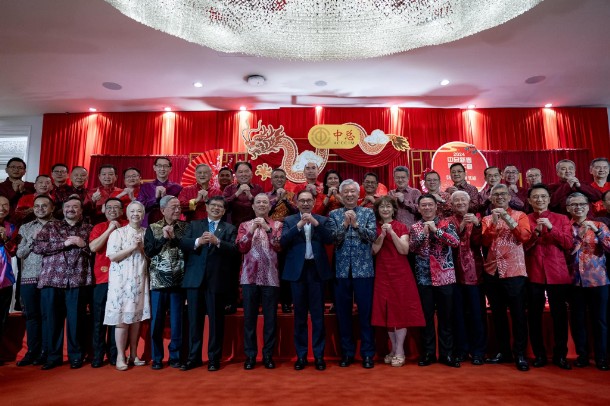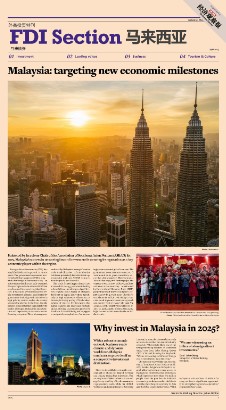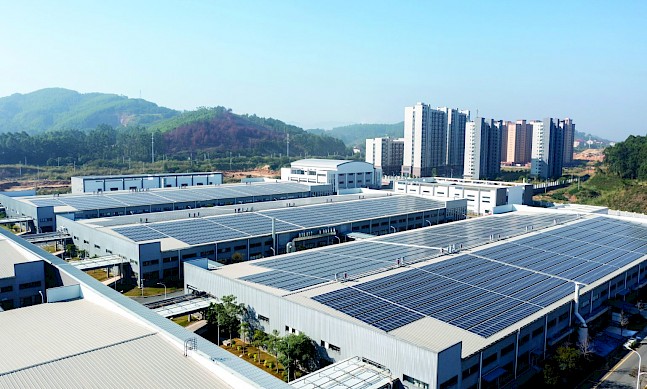Bolstered by its role as Chair of the Association of Southeast Asian Nations (ASEAN) for 2025, Malaysia’s success in attracting inward investment is securing its reputation as a key economic player within the region.
Foreign direct investment (FDI) has played a crucial role in accelerating Malaysia’s economic growth in recent years. In 2023, the government announced a record-breaking $74 billion in approved FDI, with an additional $36 billion secured by mid-2024. This remarkable achievement has not only reinforced Malaysia’s pivotal position within ASEAN but has also enhanced its attractiveness to global investors. The country’s investment-friendly environment, driven by government-backed growth initiatives in high-priority sectors, makes it a highly rewarding destination for businesses. Beyond these incentives, Malaysia’s appeal is further strengthened by its well-developed technology infrastructure and a robust, cross-sector manufacturing ecosystem. Additionally, the country’s strategic location in the South China Sea serves as a significant advantage, enabling lucrative trade opportunities with both ASEAN and non-ASEAN partners, including India and Australia. These factors collectively position Malaysia as a highly competitive and dynamic player in the global economy.

Malaysia’s trade-focused approach reflects a broader global shift among governments seeking to capitalize on the proliferation of global value chains. In particular, Malaysia’s emphasis on digital innovation, especially in high-value sectors like semiconductors, has already yielded significant benefits, as seen in the substantial volume of exports. For investors, this positions Malaysia as a smart and strategic choice, offering both a gateway to Southeast Asia and the capability to navigate the complexities of an increasingly interconnected global economy. Further strengthening this outlook is the government’s commitment to structural reform and its green transition, spearheaded by the New Industrial Master Plan 2030. These initiatives are set to drive Malaysia toward a more inclusive, resilient, and sustainable economy—a trajectory reinforced by the International Monetary Fund (IMF), which projects the country’s output to grow by 4.7% in 2025. The IMF’s confidence is well-founded, as Malaysia has made significant strides in fostering economic growth and reducing poverty over the past few decades. With these continued efforts, the nation is well on track to achieving high-income status by the end of the decade.

Why invest in Malaysia in 2025?
With a strong economic outlook, a business-friendly environment, and a dynamic workforce, Malaysia continues to establish itself as a highly competitive investment destination.
Malaysia is rapidly emerging as the preferred overseas hub for shared services and leading technology industries. The country’s well-established infrastructure and regulatory stability provide the assurance that organizations seek, while its skilled workforce and strong commitment to innovation ensure businesses have access to talent that meets industry demands. As Dato’ John Chong, Group CEO of Global Banking for Maybank, notes, “Malaysia is likely one of the best-performing markets in Southeast Asia. We are witnessing an influx of foreign direct investments into Malaysia.” This growing investment trend further cements Malaysia’s position as a prime destination for global businesses looking to expand in the region.
“We are witnessing an influx of a foreign direct investments.”
Dato’ John Chong Group CEO of Global Banking, Maybank
Tweet ThisMalaysia’s role within the Association of Southeast Asian Nations (ASEAN) further enhances its appeal, providing investors with seamless access to the region’s interconnected economies, which collectively represent over 672 million people. Over the past decade, ASEAN’s rapid economic growth has positioned it as the third-largest economy in Asia and the fifth-largest globally. Looking ahead, Malaysia’s upcoming role as Chair of ASEAN in 2025 presents a significant opportunity to strengthen regional cooperation. As Dato’ John Chong notes, “With Malaysia’s role as Chair of ASEAN for 2025, we have a significant opportunity to strengthen regional cooperation,” reinforcing the country’s influence in shaping the region’s economic future.
Harnessing innovation for growth

Malaysia’s Ministry of Science, Technology, and Innovation (MOSTI) is actively working toward achieving high-tech nation status by driving technological advancements through strategic policies and regulations. At the core of this effort is a focus on agile governance, aimed at enhancing the country’s global competitiveness. A key objective is the development of science, technology, and innovation (STI) enablers, ensuring that Malaysia builds sustainable sector capacity while addressing national priorities.
Since his appointment in 2022, Minister of Science, Technology, and Innovation Chang Lih Kang has been at the forefront of these initiatives. With a background in engineering and a deep passion for innovation, he is well-positioned to propel Malaysia’s tech ambitions forward. His vision for the ministry is to foster technological progress through effective and inclusive governance, ultimately creating a more advanced and prosperous future for all Malaysians.

“Malaysia’s many technology centres facilitate innovation and growth.”
Chang Lih Kang Minister of Science, Technology and Innovation
Tweet ThisQ: How are you cultivating the talent Malaysia needs to develop AI?
Our AI Roadmap outlines strategies to foster AI talent, focusing on offering comprehensive and inclusive AI education, reskilling and upskilling the existing workforce, as well as attracting and retaining AI talent. Investment in research and development (R&D) is another key strategy.
Q: What are the opportunities for collaboration between Malaysia and China?
Recent agreements between Malaysia and China open up several promising opportunities for collaboration in the technology sector, including the Malaysia Startup Ecosystem Roadmap, empowering startups to tap into potential opportunities; the KL20 Action Plan, designed to attract international investors to invest in Malaysian technology-based startups; and MRANTI Park technology hub.
Q: How is Malaysia developing its innovation ecosystem to attract FDI?
The National Technology and Innovation Sandbox enables researchers and entrepreneurs to test products in a live environment. It also offers grants to accelerate the transition from R&D to market readiness. Similarly, a 5G Experience Centre features a prototyping, testing and demo lab to showcase industry-specific applications. MRANTI’s autonomous vehicle experimental lab is focused on research and testing for autonomous and next-generation vehicles.
Q: What advantages can Malaysia offer to Chinese investors in STI?
The government offers a variety of incentives for foreign STI investors, including tax breaks, grants and funding schemes under the Malaysian Investment Development Authority and MOSTI. Malaysia is known for its political stability and pro-business policies and has a large pool of STEM talent, with top-tier universities and research institutions.
Q: Why is Malaysia becoming such a valued environment for investors?
Over the past two years, a total of US$14.5 billion has been committed to the development of data centres in Malaysia by tech giants such as Google, Microsoft, NVIDIA and Amazon. Malaysia’s many technology centres facilitate innovation and growth through collaborative spaces, funding opportunities and industry connections.
Q: How significant is the renewables sector for Malaysia’s future economy?
Malaysia’s Hydrogen Economy and Technology Roadmap (HETR) is poised to significantly impact the country’s economic landscape. The growth potential for the hydrogen sector is substantial, with projections that it could generate up to US$2.71 billion in revenue and contribute up to US$13.65 billion to GDP by 2030, creating over 45,000 jobs. The HETR is a crucial component of Malaysia’s strategy to become a leader in energy transition and renewable energy.

Boosting bilateral trade
China Enterprises Chamber of Commerce in Malaysia (CECCM) was established in 2002 to enhance bilateral trade between China and Malaysia in a fair and collaborative manner. As a key organization facilitating economic ties, CECCM plays a crucial role in fostering cooperation and mutual growth between businesses from both nations. Under the leadership of its new President, Ni Qingjiu, the chamber continues to strengthen partnerships, promote investment opportunities, and create a more integrated trade environment that benefits both countries.
Q: What are CECCM’s current priorities?
We’ve been working more closely with Malaysian government agencies to get extra support for our members, helping them stay competitive. At the same time,
we’ve been boosting our efforts in public welfare to build a stronger community presence and improve how people see us. We continue to uphold our principles of coordination, networking, promotion, research, information and rights protection. International cooperation benefits everyone.
Q: What role do you play in strengthening bonds between China and Malaysia?
As Malaysia and China celebrate 50 years of diplomatic relations, the focus remains on fostering business collaborations, supporting digital transformation, and advocating for policy improvements. Key initiatives include a planned collaboration with the Malaysia Digital Economy Corporation and a strategic partnership in the Malaysia-China Summit held last December. These efforts aim to strengthen economic ties and drive mutual growth in the evolving digital landscape.

“China continues to be Malaysia’s largest trading partner.”
Ni Qingjiu President, China Enterprises Chamber of Commerce in Malaysia (CECCM)
Tweet ThisQ: What were the main objectives of the summit?
The summit served as a significant opportunity to deepen the relationship between Malaysia and China, with a focus on long-term economic growth. CECCM views this as a crucial moment to reinforce its ongoing efforts and align strategies with the broader goals of both nations. The agreements reached during the summit have laid the foundation for continued economic cooperation, positioning both countries to thrive in an increasingly complex global market.
Q: What makes China such an important trading partner?
According to 2024 statistics, China continues to be Malaysia’s largest trading partner, making up 17% of Malaysia’s total trade.
Q: What benefits can members expect from CECCM?
The majority of our members are Chinese investors who have established businesses in Malaysia, alongside local companies such as law firms, medical centers, and hotels that offer services to these enterprises. We serve as a bridge, connecting our members with key stakeholders in China and assisting them in building a strong and respected presence in the Chinese market.
Q: How has your leadership influenced CECCM’s vision?
Since stepping into the role, I’ve been working to make sure everything we do at CECCM matches up with the goal of improving business between China and Malaysia, to better support our members as things change rapidly.




